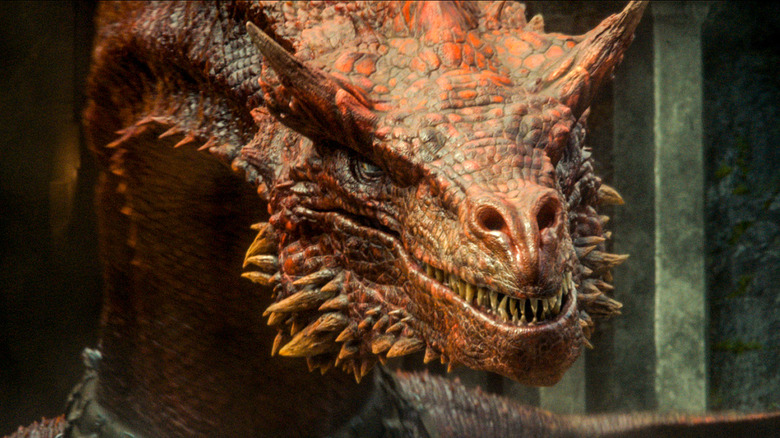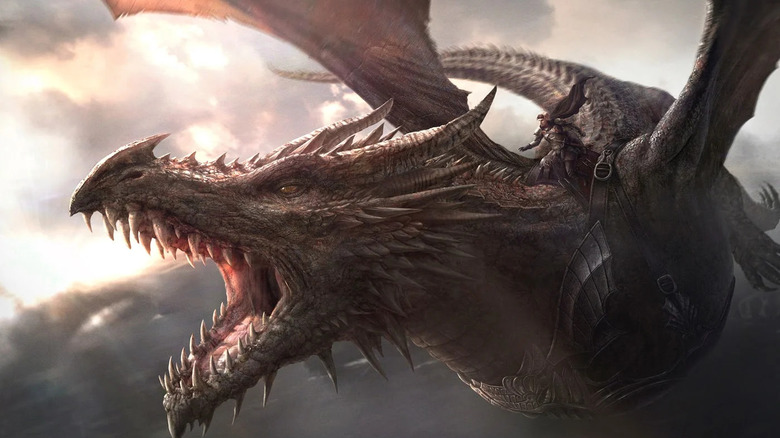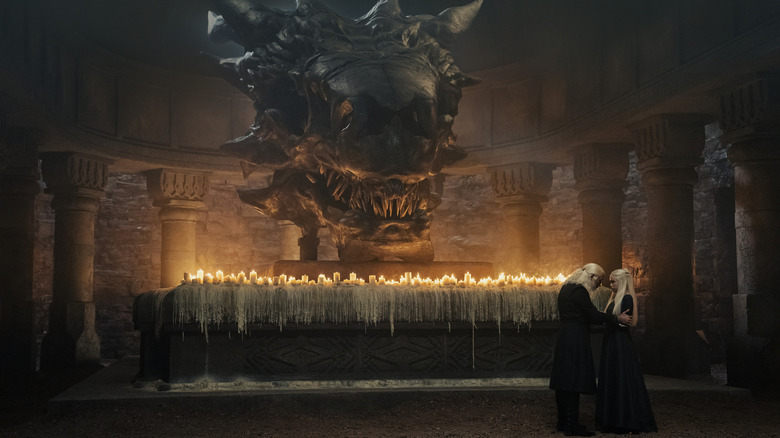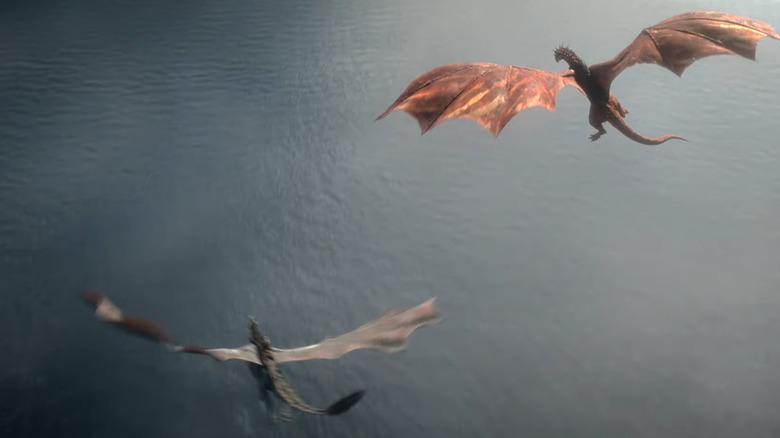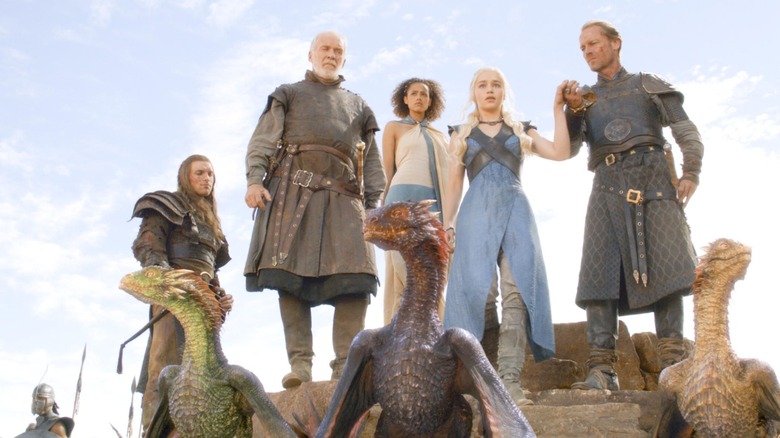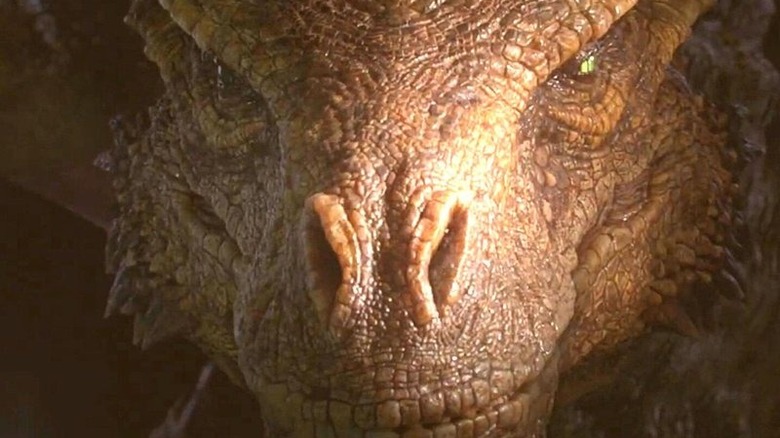The 5 Most Interesting Bits Of Dragon Lore In House Of The Dragon
They might just be big fire-breathing lizards, but the three dragons on "Game of Thrones" were beloved by fans, and there are many more dragons in the prequel series, "House of the Dragon." While Daenerys Targaryen (Emilia Clarke) had to kind of wing it when it came to raising her trio, the characters on "House of the Dragon" have the knowledge of centuries of dragon-rearing passed down from dragonrider to dragonrider. Since dragons are the great weapon of the Targaryen dynasty, they are feared, respected, and (by some) loved.
In the second episode of "House of the Dragon," we learn that the Targaryens always put a dragon egg in the cradle with newborns, so the infant and the dragon can become bonded. That detail made me wonder about the dragons in general, since the three in "Game of Thrones" were anomalies. We know the dragon's diet (charred meat, cooked by their fiery breath), but nothing about their lifespans, anatomy, or training. Thankfully, there's loads of information about the flying beasts in the books written by George R. R. Martin, including the expansive worldbuilding book of Westeros' history, "The World of Ice and Fire."
Here are five of the most fascinating facts about the dragons in Martin's world, along with some more details about the specific dragons of "House of the Dragon."
If given room, they can grow forever
Dragon hatchlings aren't very big, and Dany's trio of Drogon, Rhaegal, and Viserion were pretty typical for baby dragons despite hatching 150 years after the rest of their species had gone extinct. Hatchlings are close to cat-sized, though they grow very quickly. In the fifth book in the "Song of Ice and Fire" saga, "A Dance of Dragons," Martin reveals that dragons will continue to grow forever as long as they have enough food and room to roam. Dragons given free rein and lots of fresh meat can grow to a size suitable for riding in fewer than two years.
The largest dragon in recorded history was also the oldest, Balerion the Dread, whose great skull is seen on display in both "House of the Dragon" and "Game of Thrones." But size doesn't always correlate with age if the dragons have been kept captive in castle keeps. Balerion was allowed to roam pretty much as he pleased, and became large enough to swallow a mammoth whole.
Their bones are black
While this is something that wasn't portrayed accurately in "Game of Thrones," the bones of dragons are as black as dragonglass, and when polished can look like onyx. Tyrion (played by Peter Dinklage in the show) explains this in the first novel in the series, "A Game of Thrones," when he walks through the crypts beneath King's Landing, where the skulls of the last Targaryen dragons are kept.
In "House of the Dragon," we see the polished skull of Balerion beneath the castle, with many candles lit in his honor. Belarion was the largest and oldest of all Targaryen dragons, and was the former mount of King Viserys (Paddy Considine) before the dragon died of old age. Viserys never took another dragon after Balerion's death, though some dragonriders do take another mount if theirs dies.
Dragon bones are harder than steel, but much more flexible. The bones are used for the hilts of Valyrian steel weapons, jewelry, longbows, and more, making them very valuable.
They might be able to change sex
Remember how the dinosaurs in "Jurassic Park" were able to change their sex in order for females to reproduce with one another, thanks to their bits of frog DNA? It turns out that the dragons in "House of the Dragon" might share a similar trait, as the maesters and septons can't seem to agree on how to determine the sex of a dragon beyond seeing if it lays eggs. Dragons known to lay eggs are often called she-dragons or dragon queens, like Rhaenyra's Syrax and Rhaenys' Meleys.
In the fourth book in the series, "A Feast for Crows," Samwell Tarly discovers that some of the world's historians and scientists, including Maester Aemon (Peter Vaughan) believe that dragons can change their sex at will. Others argue that they have fixed reproductive traits, but since no one has recorded them beyond who can lay eggs, the sex of dragons is still mostly a mystery.
Their scale colors don't mean anything
In some fantasy worlds, the color of a dragon's scales can be an indicator of more than just its basic appearance. In Anne McCaffrey's "Dragonriders of Pern" novels, the dragon's color defines both its sex and physical prowess. Green and gold dragons are all female, for example. In "Dungeons and Dragons" lore, the colors of dragons have to do with their subspecies and where they live. Moreover, the metallic colored dragons are good, while the chromatic ones are evil.
When it comes to "Game of Thrones" and "House of the Dragon," however, the colors mean absolutely nothing. In a video tweet from HBO, Martin answered fan questions and explained that the colors of the dragons in his world are based on the colors of various reptiles in nature, and have no relationship to the dragon's personality, sex, or abilities. He also mentioned that he was inspired by some of the truly colorful species of snakes in the wild, and that he wanted to bring some of the unique colorations to the many dragons on "House of the Dragon," so we could be seeing some interesting new patterns or colors on the series.
They can live for centuries
We know that dragons grow really fast, but how long can they live? Unfortunately, because dragons are living weapons of war, the vast majority of them die from injuries in battle. In fact, Balerion was the only dragon on record to die of old age, and he was well over 200 years old before he died. In "Fire & Blood," the book "House of the Dragon" is based on, Martin reveals that no one knows exactly how long dragons live exactly, as Balerion is their only example of a "natural" death in dragonkind.
The dragons of "House of the Dragon" haven't played too major a role yet besides displays of power, but as the oncoming war is called the Dance of the Dragons, fans should prepare to see plenty of dragon blood shed. "Game of Thrones" fans who paid close attention and those who have read "Fire & Blood" already know how this ends, and it's appropriately grim for Martin's world.
New episodes of "House of the Dragon" debut Sundays on HBO and HBO Max.
